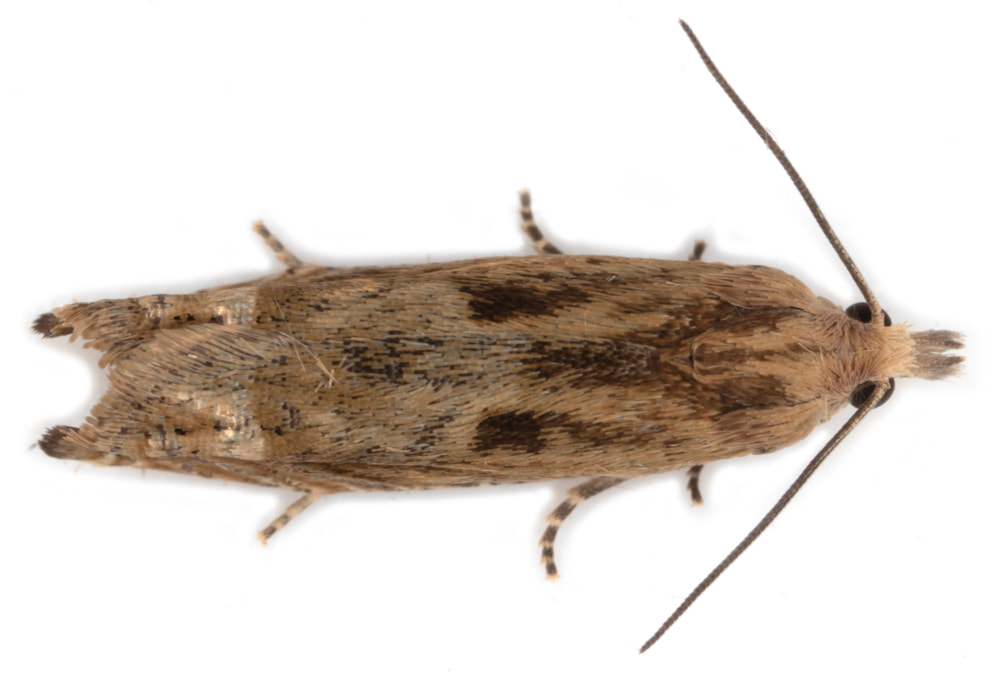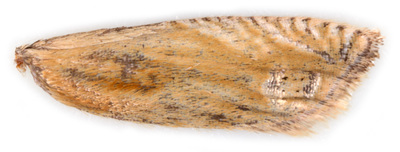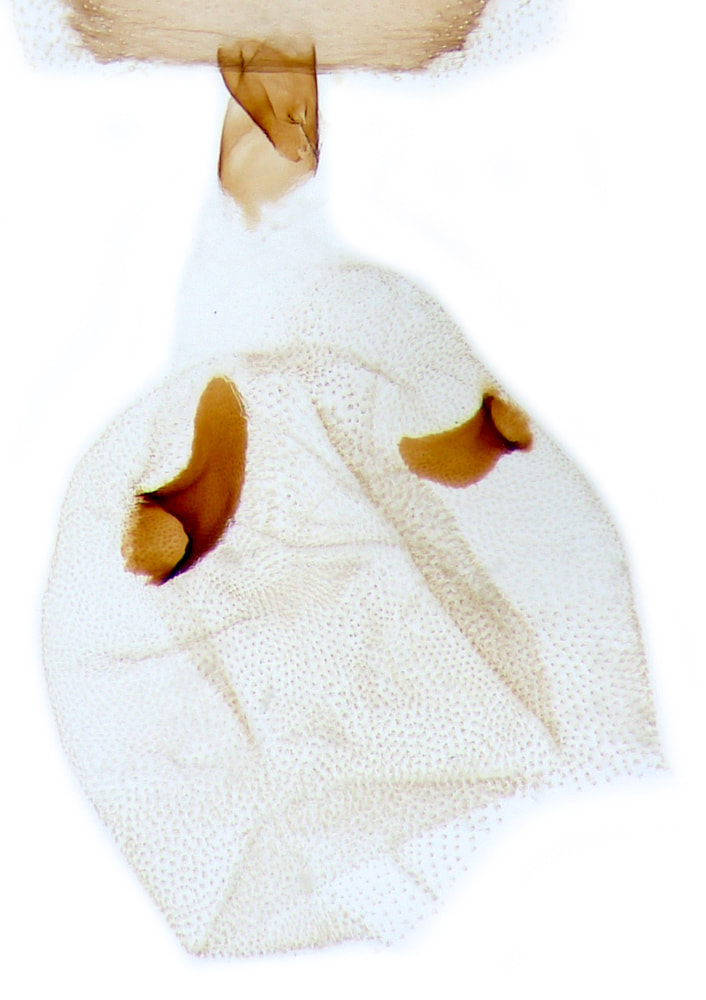49.266 Eucosma hohenwartiana (Common Knapweed Tortrix)
ws: 11-23mm; Jun-Aug; common knapweed (Centaurea nigra); common throughout GB except N.Scotland
Synonym: Catoptria fulvana (Pierce & Metclafe)
Synonym: Catoptria fulvana (Pierce & Metclafe)
ID: Very variable in size; in colour from grey-white to white-ochreous; in suffusion with brown, which may obscure the medio-dorsal patch of light ground colour. Distinguished from E.cana by absence of white forewing streaks and generally darker ground colour; and from E.obumbratana by strongly developed costal strigulae in apical half of forewing and again by generally darker ground colour - fulvous in E.obumbratana.
Formerly considered conspecific with E.parvulana and E.fulvana. E.parvulana averages smaller (14-19mm) and has more uniformly coloured forewings. E.fulvana is large (fw 19-25mm) and fulvous. There are no male genital differences between these two species and E.hohenwartiana - they can only be reliably distinguished on the basis of larval foodplant. Moth DIssection suggests a difference in the dimensions of S8 in the female.
Male genitalia: The valva of E.hohenwartiana is distinguished from E.cana by a longer cucullus with a well-developed lobe, a shorter less robust neck and a more angulate ventral margin to the sacculus; and from E.obumratana by the absence of a pulvinus. (Dissection group comments that a pulvinus is "normally lacking in E.cana and E.hohenwartiana" which implies that it may be present sometimes). See Eucosma for more detail.
Female genitalia: In E.hohenwartiana/parvulana/fulvana the cingulum is fully visible anterior to the subgenital sternite; in all other Eucosma species the cingulum is at least partly covered by the sternite. In E.hohenwartiana the ovipositor (measured from the apex of the anal papillae to the anterior end of a posterior apohysis) is twice as long as an anterior apophysis; in E.parvulana/fulvana the ovipositor is less than twice as long as an anterior apophysis. In E.hohenwartiana the 8th sternite is twice as long as broad; in E.parvulana the 8th sternite is about as long as broad; and in E.fulvana the 8th sternite is slightly broader than long.
Formerly considered conspecific with E.parvulana and E.fulvana. E.parvulana averages smaller (14-19mm) and has more uniformly coloured forewings. E.fulvana is large (fw 19-25mm) and fulvous. There are no male genital differences between these two species and E.hohenwartiana - they can only be reliably distinguished on the basis of larval foodplant. Moth DIssection suggests a difference in the dimensions of S8 in the female.
Male genitalia: The valva of E.hohenwartiana is distinguished from E.cana by a longer cucullus with a well-developed lobe, a shorter less robust neck and a more angulate ventral margin to the sacculus; and from E.obumratana by the absence of a pulvinus. (Dissection group comments that a pulvinus is "normally lacking in E.cana and E.hohenwartiana" which implies that it may be present sometimes). See Eucosma for more detail.
Female genitalia: In E.hohenwartiana/parvulana/fulvana the cingulum is fully visible anterior to the subgenital sternite; in all other Eucosma species the cingulum is at least partly covered by the sternite. In E.hohenwartiana the ovipositor (measured from the apex of the anal papillae to the anterior end of a posterior apohysis) is twice as long as an anterior apophysis; in E.parvulana/fulvana the ovipositor is less than twice as long as an anterior apophysis. In E.hohenwartiana the 8th sternite is twice as long as broad; in E.parvulana the 8th sternite is about as long as broad; and in E.fulvana the 8th sternite is slightly broader than long.
§1 Foulness, Essex; 11/07/2010; male; fw 9.2mm
§2 Arnside, Cumbria; 26/07/2013; male; fw 8.0mm
§3 Ambleside, Cumbria; 16/07/2015; male; fw 8.8mm; to light
§4 Ambleside, Cumbria; 16/07/2015; male; fw 9.0mm; to light
§5 Portland, Dorset; 23/06/2015; male; fw 9.3mm; to light
§6 Foulden Common, Norfolk; 29/06/2017; male; fw 8.3mm
§7 Sutton Fen, Norfolk; 17/07/2017; male; fw 8.7mm
§8 Stour Wood, Essex; 14/07/2021; female; fw 8.7mm; to light
§9 Covert Woods, Kent; 06/07/2022; female; fw 9.4mm
All images © Chris Lewis
§2 Arnside, Cumbria; 26/07/2013; male; fw 8.0mm
§3 Ambleside, Cumbria; 16/07/2015; male; fw 8.8mm; to light
§4 Ambleside, Cumbria; 16/07/2015; male; fw 9.0mm; to light
§5 Portland, Dorset; 23/06/2015; male; fw 9.3mm; to light
§6 Foulden Common, Norfolk; 29/06/2017; male; fw 8.3mm
§7 Sutton Fen, Norfolk; 17/07/2017; male; fw 8.7mm
§8 Stour Wood, Essex; 14/07/2021; female; fw 8.7mm; to light
§9 Covert Woods, Kent; 06/07/2022; female; fw 9.4mm
All images © Chris Lewis
Page published 27/01/2013 (§1) | §2 added 06/12/2013 | Female genitalia text added 21/04/2014 | §3&4 added 10/12/2015 |
§5 added 02/03/2016 | §6 added 08/04/2018 | §7 added 17/04/2018 | §8 added 12/08/2021 | §9 added 11/12/2022
§5 added 02/03/2016 | §6 added 08/04/2018 | §7 added 17/04/2018 | §8 added 12/08/2021 | §9 added 11/12/2022







































